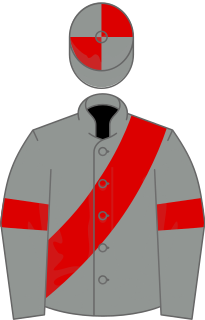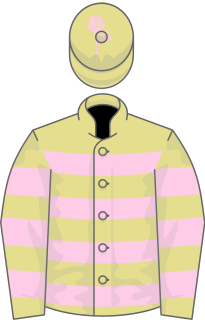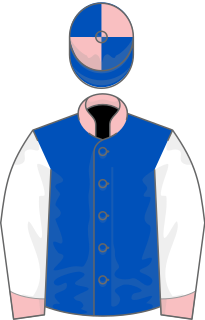Related Research Articles
Humble Duty (1967–1975) was an Irish-bred, British-trained Thoroughbred racehorse. In a racing career lasting from May 1969 until September 1970, the filly ran eleven times and won eight races. As a two-year-old she was rated the best of her age and sex in Britain after winning the Lowther Stakes at York and the Cheveley Park Stakes at Newmarket. In the following season she won five races, all over one mile, including the 1000 Guineas at Newmarket, the Coronation Stakes at Royal Ascot and the Sussex Stakes at Goodwood. She was retired to stud at the end of that season, but had little chance to make an impact as a broodmare, dying in 1975 at the age of eight.
Shadayid was an American-bred, British-trained Thoroughbred racehorse and broodmare. In a racing career which lasted from June 1990 to November 1991 she ran eleven times winning five races and being placed five times. Shadayid was one of the leading two-year-old fillies in Europe in 1990, winning all three of her races including the Group One Prix Marcel Boussac at the Longchamp. After winning the Fred Darling Stakes on her three-year-old debut, Shadayid took her unbeaten run to five by winning the Classic 1000 Guineas at Newmarket. Although she never won again, she finished second in the Coronation Stakes and the Sussex Stakes and third in the Haydock Sprint Cup and the Queen Elizabeth II Stakes. Shadayid was retired from racing to become a broodmare at the end of her three-year-old season after finishing seventh in the Breeders' Cup Mile.

Midway Lady was an American-bred, British-trained Thoroughbred racehorse and broodmare who won two British Classic Races in 1986. In a racing career lasting from August 1985 until June 1986, the filly ran six times and won her last five races. She sustained her only defeat when finishing second on her racecourse debut but won her remaining three races in 1985 including the May Hill Stakes at Doncaster and the Prix Marcel Boussac at Longchamp. Her three-year-old campaign consisted of only two races, as she won the 1000 Guineas at Newmarket and the Oaks at Epsom a month later. After sustaining a serious leg injury, she was retired to stud where she became a successful producer of winners including the Oaks winner Eswarah.
Abermaid was an Irish-bred, British-trained Thoroughbred racehorse and broodmare who won the classic 1000 Guineas in 1962. In a racing career lasting from the spring of 1961 until July 1962, the filly ran eight times and won four races. As a two-year-old in 1961, Abermaid was unbeaten in three races including the New Stakes at Royal Ascot. After running poorly on her three-year-old debut she recorded an upset win in the 1000 Guineas at Newmarket Racecourse in May. She was placed in her three remaining races before being retired to stud where she had some success as a broodmare.
Fleet, known in the United States as Fleet II, was an Irish-bred, British-trained Thoroughbred racehorse and broodmare who won the classic 1000 Guineas in 1967. In a racing career lasting from June 1966 until July 1967, the filly contested nine races and won five times. As a two-year-old in 1966, Fleet won two of her three races including the Cheveley Park Stakes and was the highest rated filly of her age in Britain. In the following year she won three races over a distance of one mile including the 1000 Guineas and the Coronation Stakes. When tried over longer distances she finished fourth in The Oaks and Eclipse Stakes. She was retired to stud where she had some success as a broodmare in Britain and the United States.
Waterloo was British Thoroughbred racehorse and broodmare best known for winning the classic 1000 Guineas in 1972. Waterloo was one of the leading British two-year-olds of 1971 when her wins included the Queen Mary Stakes and the Cheveley Park Stakes. In the following year she followed up her victory in the Guineas by winning the Falmouth Stakes. She was later sold and exported to the United States and had some success as a broodmare.

Circus Plume (1981–1996) was a British Thoroughbred racehorse and broodmare best known for winning the classic Oaks Stakes in 1984. After winning once from three starts in 1983, Circus Plume improved to become one of the best staying fillies in Europe as a three-year-old, winning the Oaks and the Yorkshire Oaks as well as finishing second in the Irish Oaks and the Prix Vermeille. She failed to show any worthwhile form in 1985 and was retired to stud, where she had some success as a broodmare.
Marwell was an Irish-bred, British-trained Thoroughbred racehorse and broodmare. A specialist sprinter, she won ten of her thirteen races, including several against colts and older horses, and was the highest-rated filly of her generation in Europe at both two and three years of age. She won all five of her races as a two-year-old in 1980, including the Molecomb Stakes, Flying Childers Stakes, and Cheveley Park Stakes. In the following year, she was beaten over a mile in the classic 1000 Guineas but returned to sprinting to win the King's Stand Stakes July Cup and Prix de l'Abbaye. She was retired from racing at the end of 1981 and became a successful broodmare. Marwell died in 2003.
Fairy Footsteps was a British Thoroughbred racehorse and broodmare best known for winning the classic 1000 Guineas in 1981. She showed promise in her first two races as a two-year-old before establishing herself as one of the best fillies of her generation with an emphatic win in the Waterford Candelabra Stakes. In the spring of 1981 she was heavily backed for the 1000 Guineas before and after a win in the Nell Gwyn Stakes. She won the 1000 Guineas by leading all the way and was considered highly likely to follow up with a win in the Epsom Oaks but was retired after a disappointing defeat in the Musidora Stakes. She had some success as a broodmare.
One in a Million was an Irish-bred, British-trained Thoroughbred racehorse and broodmare best known for winning the classic 1000 Guineas in 1979. She won both her races as a two-year-old in impressive style and began her three-year-old season with a five length win in the Nell Gwyn Stakes. She won the 1000 Guineas as a short-priced favourite and was awarded victory in the Coronation Stakes on the disqualification of Buz Kashi. She lost her unbeaten record when finishing unplaced in the July Cup and never raced again. After being retired from racing she had considerable success as a broodmare. She died in 1992.
Cloonlara was an American-bred, Irish-trained Thoroughbred racehorse and broodmare. Although she never contested a Group One race as a two-year-old, Cloonlara was regarded as the best juvenile filly to race in Europe in 1976. She won all three of her races that year by wide margins, culminating in a six length win over colts in the Phoenix Stakes. She missed the rest of the season through injury and failed to reproduce her best form in 1977, when she became increasingly temperamental. Cloonlara made a highly-promising start to her breeding career before dying at the age of seven in 1981.
Cherry Hinton was an American-bred, British-trained Thoroughbred racehorse and broodmare. Despite never competing above Group Three level, she was officially rated the best two-year-old filly in Britain, and was rated the best juvenile filly in Europe by Timeform. She ran well in defeat in her first two races before winning the Tadcaster Stakes at York Racecourse and then establishing her reputation with a wide-margin victory in the Argos Star Fillies' Mile. She was expected to play a leading role in the following season's classics but had a series of training problem and failed to win in three starts. She later had some success as a broodmare.

Polygamy was a British Thoroughbred racehorse, best known for winning the classic Epsom Oaks in 1974. As a two-year-old in 1973, she showed promise by winning three races and finishing fourth in the Critérium des Pouliches. In the following spring she won the 1000 Guineas Trial Stakes and was narrowly beaten in the 1000 Guineas before winning the Oaks. She was retired after being beaten in her only subsequent race and died without producing a foal.
Olwyn was a British Thoroughbred racehorse and broodmare best known for her win in the 1977 Irish Oaks. A daughter of The Derby winner Relko she won once from twelve races in 1976 and 1977. She finished no better than third in four starts as a two-year-old, but showed promising form in the spring of 1977, finishing second in the Pretty Polly Stakes and the Lancashire Oaks. After failing to win in her first nine races she recorded her first and only victory when narrowly winning a poorly contested Irish Oaks in July 1977. She was well beaten in two subsequent races and retired at the end of the year. She made little impression as a broodmare.

Sleeping Partner was a British-bred thoroughbred racehorse and broodmare. She showed modest form as a juvenile in 1968 but developed into a top class performer in the following year, winning the Lingfield Oaks Trial, Epsom Oaks and Ribblesdale Stakes. She did not win again and was retired from racing in 1970. She produced no known foals.

Pia was a British-bred Thoroughbred racehorse and broodmare. She showed top-class form as a juvenile in 1966 when she won three races including the Cherry Hinton Stakes and the Lowther Stakes as well as finishing second in the Cheveley Park Stakes. In the following year she ran fourth in the 1000 Guineas and third in the Musidora Stakes before recording her biggest win in the Epsom Oaks. Later that year she dead-heated for first place in the Park Hill Stakes and ran fourth in a strong renewal of the Champion Stakes before being retired from racing. Although her foals made little impact on the track, her daughter Principia became an influential broodmare.

Valoris was a French-bred, Irish-trained Thoroughbred racehorse and broodmare. After showing promising form without winning a race as a juvenile in 1965 she developed into a top-class performer the following spring when she recorded emphatic victories in the Irish 1000 Guineas and the Epsom Oaks. She was well beaten in two subsequent starts and was retired from racing at the end of the year. She later had considerable success as a broodmare.
Toboggan was a British Thoroughbred racehorse and broodmare. She showed very promising form as a juvenile in 1928 when she won three of her four races including the Dewhurst Stakes. In the following year she finished third in the 1000 Guineas and went on to win the Epsom Oaks, Coronation Stakes and Jockey Club Stakes. She had some success as a broodmare producing the top-class winner Bobsleigh and Hydroplane, the dam of Citation.
Beam was a British Thoroughbred racehorse and broodmare. As a juvenile she showed promise by winning one race and finishing third in the Molecomb Stakes. In the following year she finished fourth in the 1000 Guineas and won the Haverhill Stakes before beating a strong field to take the Epsom Oaks in a race record time which stood for more than half a century. She was retired from racing at the end of the season. Beam made no impact as a dam of winners and died in 1941 at the age of seventeen.
Cinna was a British Thoroughbred racehorse and broodmare. She showed great promise as a juvenile in 1919 when she won a very competitive maiden race on her debut before finishing second in the New Stakes and the Bretby Stakes. As a three-year-old she won the 1000 Guineas and the Coronation Stakes and was narrowly beaten when favourite for the Epsom Oaks. She was retired from racing at the end of the year and went on to be a very successful broodmare. Three of her sons became leading sires in Australasia whilst several of her daughters became influential broodmares including the female-line ancestors of Sunday Silence and Indian Ridge.
References
- 1 2 3 "Full Dress for Oaks". Evening Times . 6 June 1969. p. 12. Retrieved 2013-05-27.
- ↑ "Full Dress image". sporthorse-data.com. Retrieved 2013-05-27.
- 1 2 "Thoroughbred Bloodlines – Lily Agnes – Family 16-h". Bloodlines.net. Retrieved 2013-05-26.
- 1 2 Mortimer, Roger; Onslow, Richard; Willett, Peter (1978). Biographical Encyclopedia of British Flat Racing. Macdonald and Jane's. ISBN 0-354-08536-0.
- 1 2 "Full Dress in flight". Saskatoon Star-Phoenix. 2 May 1969. p. 23. Retrieved 2013-05-27.
- ↑ "Full Dress, 7-1, Is Victor By 1 1/2 Lengths in England". New York Times. 1 May 1969. Retrieved 2013-05-27.
- 1 2 Timeform (1984). Racehorses of 1983. Timeform. ISBN 0-900599-40-5.
- ↑ Morris, Tony; Randall, John (1990). Horse Racing: Records, Facts, Champions (Third ed.). Guinness Publishing. ISBN 0-85112-902-1.
- ↑ Morris, Tony; Randall, John (1999). A Century of Champions. Portway Press. ISBN 978-1-901570-15-1.
- ↑ "Full Dress pedigree". Equineline. 2012-05-08. Retrieved 2013-05-26.